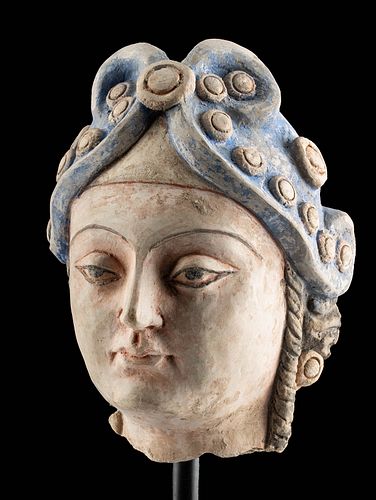Stunning Gandharan Polychrome Stucco Bust of a Lady
Lot 134a
About Seller
Artemis Fine Arts
686 S Taylor Ave, Ste 106
Louisville, CO 80027
United States
Selling antiquities, ancient and ethnographic art online since 1993, Artemis Gallery specializes in Classical Antiquities (Egyptian, Greek, Roman, Near Eastern), Asian, Pre-Columbian, African / Tribal / Oceanographic art. Our extensive inventory includes pottery, stone, metal, wood, glass and textil...Read more
Categories
Estimate:
$8,000 - $12,000
Absentee vs Live bid
Two ways to bid:
- Leave a max absentee bid and the platform will bid on your behalf up to your maximum bid during the live auction.
- Bid live during the auction and your bids will be submitted real-time to the auctioneer.
Bid Increments
| Price | Bid Increment |
|---|---|
| $0 | $25 |
| $300 | $50 |
| $1,000 | $100 |
| $2,000 | $250 |
| $5,000 | $500 |
| $10,000 | $1,000 |
| $20,000 | $2,500 |
| $50,000 | $5,000 |
| $100,000 | $10,000 |
| $200,000 | $20,000 |
About Auction
By Artemis Fine Arts
Jun 10, 2021
Set Reminder
2021-06-10 10:00:00
2021-06-10 10:00:00
America/New_York
Bidsquare
Bidsquare : Exceptional Antiquities | Asian | Ethnographic
https://www.bidsquare.com/auctions/artemis-gallery/exceptional-antiquities-asian-ethnographic-7012
Museum-worthy examples of Egyptian, Greek, Roman, Viking, Near Eastern, Far East / Asian, Pre-Columbian, African / Tribal, Oceanic, Native American, Spanish Colonial, Russian, Fossils, Ancient Jewelry, Fine Art, so much more! Artemis Fine Arts info@artemisfinearts.com
Museum-worthy examples of Egyptian, Greek, Roman, Viking, Near Eastern, Far East / Asian, Pre-Columbian, African / Tribal, Oceanic, Native American, Spanish Colonial, Russian, Fossils, Ancient Jewelry, Fine Art, so much more! Artemis Fine Arts info@artemisfinearts.com
- Lot Description
Central Asia, Pakistan, India, and Afghanistan, Gandharan culture, ca. 2nd to 3rd century CE. A rare and marvelous stucco head of a noble woman adorned in vibrant hues of peach, cobalt, caramel, salmon pink, white, and black. Embodying the paragon of idealized beauty, her refined visage is dominated by a pair of stunning, heavy-lidded eyes of ebony, elongated into a cat eye-like effect and highlighted by black eyeliner, all beneath a dramatic pair of slender, sweeping brows. Below her eyes are a dignified nose, a pronounced philtrum, bowed lips, and a slightly extended chin, framed by black ringlets of hair that cascade down the sides of her face. She wears an ornate, blue headdress, similar to a turban and adorned with a central target-motif pendant and 17 additional circular embellishments of smaller scale. Flanked by a pair of annular earrings, her modest cheek bones rise above gentle dimples, rendering her supple skin nearly flesh-like. A quixotic portrait of the ancient aesthetic; her arresting guise and alluring gaze transcends time, enticing even the most heedful of viewers. Size: 5.25" W x 7" H (13.3 cm x 17.8 cm); 11.75" H (29.8 cm) on included custom stand.
Alexander the Great conquered Gandhara in 330 BCE and with the help of the Indo-Greek kings introduced classical traditions that would influence Gandharan art for the following seven centuries. The stylized curly Mediterranean hair of this bust derives from classical sculptures such as the Apollo Belvedere (330 BCE), and the sensitive modeling of the expressive face demonstrates a classical influence as well.
Gandharans are famous for schist and stucco carvings, with stucco replacing schist as the dominant sculptural material around the 3rd century CE. Vast monastic institutions like those at Takht-i-Bahi, Sahri-Bahlol, Jamal Garhi, Ranigat, and Thareli were decorated by skilled artisans with stucco representations of important figures, religious scenes, and artistic dedications. Stucco allowed artists more freedom in portraying lifelike features, as shown in the gentle curve of the brow here. During this time, Gandhara was exceptionally wealthy, profiting from trade along the Silk Road; patrons had resources to spend on the arts, creating a flowering of stucco artwork. Some monumental statues had stucco hands, feet, and heads alongside clay torsos - the size of these figures was such that clay was needed to maintain their form.
Provenance: private collection, Santa Clara, California, USA, acquired prior to 2010
All items legal to buy/sell under U.S. Statute covering cultural patrimony Code 2600, CHAPTER 14, and are guaranteed to be as described or your money back.
A Certificate of Authenticity will accompany all winning bids.
We ship worldwide and handle all shipping in-house for your convenience.
#164636Fragment of a larger piece. Abraded area on verso. Very light fading of pigment. Otherwise, excellent with impressive remaining pigments and light earthen deposits.Condition
- Shipping Info
-
All shipping is handled in-house for your convenience. Your invoice from Artemis Gallery will include shipping calculation instructions. If in doubt, please inquire BEFORE bidding for estimated shipping costs for individual items.
-
- Buyer's Premium



 EUR
EUR CAD
CAD AUD
AUD GBP
GBP MXN
MXN HKD
HKD CNY
CNY MYR
MYR SEK
SEK SGD
SGD CHF
CHF THB
THB














